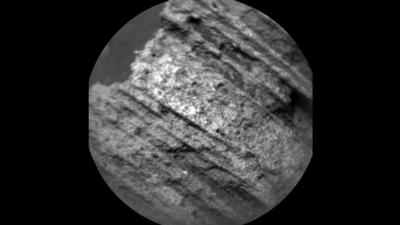Mon, Jun 01, 2015
Auto-Focus Became Inoperative Several Months Ago, NASA Says
Tests on Mars have confirmed success of a repair to the autonomous focusing capability of the Chemistry and Camera (ChemCam) instrument on NASA's Curiosity Mars rover.

This instrument provides information about the chemical composition of targets by zapping them with laser pulses and taking spectrometer readings of the induced sparks. It also takes detailed images through a telescope.
Work by the instrument's team members at Los Alamos National Laboratory in New Mexico and in France has yielded an alternative auto-focus method following loss of use of a small laser that served for focusing the instrument during Curiosity's first two years on Mars.
"Without this laser rangefinder, the ChemCam instrument was somewhat blind," said Roger Wiens, ChemCam principal investigator at Los Alamos. "The main laser that creates flashes of plasma when it analyzes rocks and soils up to 25 feet from the rover was not affected, but the laser analyses only work when the telescope projecting the laser light to the target is in focus."
For the past several months, the team has coped without auto-focusing. For each target, the instrument has taken multiple images or multiple laser analyses at different focal distances. The data were sent to Earth for selection of the in-focus image or laser analysis among the set.
The repair required sending new software to be installed on the instrument. It now takes multiple images and uses those to autonomously select the focus positions for the final images and laser analyses sent back to Earth.
"We think we will actually have better quality images and analyses with this new software than the original," said Wiens.
(Image provided by NASA. This May 15, 2015, image from the Chemistry and Camera (ChemCam) instrument on NASA's Curiosity Mars rover shows detailed texture of a rock target called "Yellowjacket" on Mars' Mount Sharp. This was the first rock target for ChemCam after checkout of restored capability for autonomous focusing.)
More News
He Attempted To Restart The Engine Three Times. On The Third Restart Attempt, He Noticed That Flames Were Coming Out From The Right Wing Near The Fuel Cap Analysis: The pilot repor>[...]
Make Sure You NEVER Miss A New Story From Aero-News Network Do you ever feel like you never see posts from a certain person or page on Facebook or Instagram? Here’s how you c>[...]
From 2009 (YouTube Edition): Leading Air Show Performers Give Their Best Advice for Newcomers On December 6th through December 9th, the Paris Las Vegas Hotel hosted over 1,500 air >[...]
Aero Linx: NASA ASRS ASRS captures confidential reports, analyzes the resulting aviation safety data, and disseminates vital information to the aviation community. The ASRS is an i>[...]
“For our inaugural Pylon Racing Seminar in Roswell, we were thrilled to certify 60 pilots across our six closed-course pylon race classes. Not only did this year’s PRS >[...]
 NTSB Final Report: Rutan Long-EZ
NTSB Final Report: Rutan Long-EZ ANN FAQ: Turn On Post Notifications
ANN FAQ: Turn On Post Notifications Classic Aero-TV: ICAS Perspectives - Advice for New Air Show Performers
Classic Aero-TV: ICAS Perspectives - Advice for New Air Show Performers ANN's Daily Aero-Linx (06.28.25)
ANN's Daily Aero-Linx (06.28.25) Aero-News: Quote of the Day (06.28.25)
Aero-News: Quote of the Day (06.28.25)



